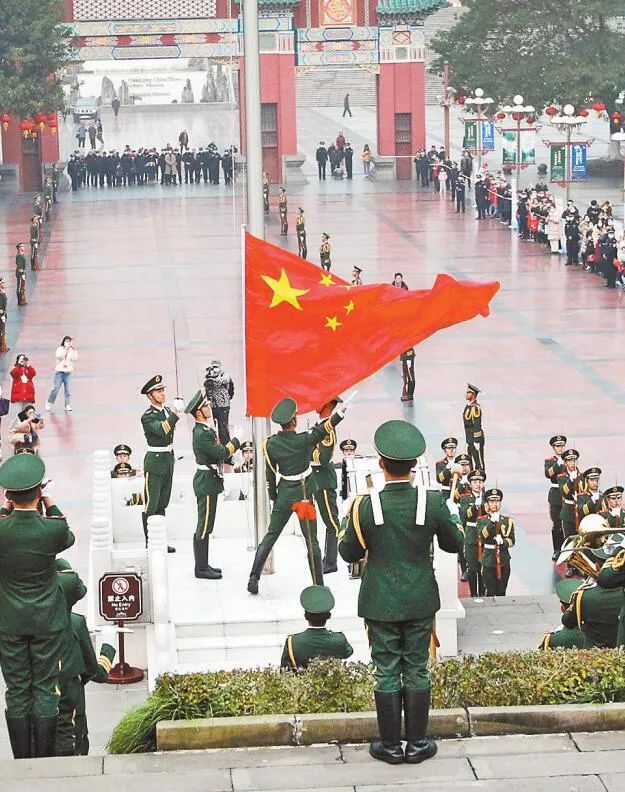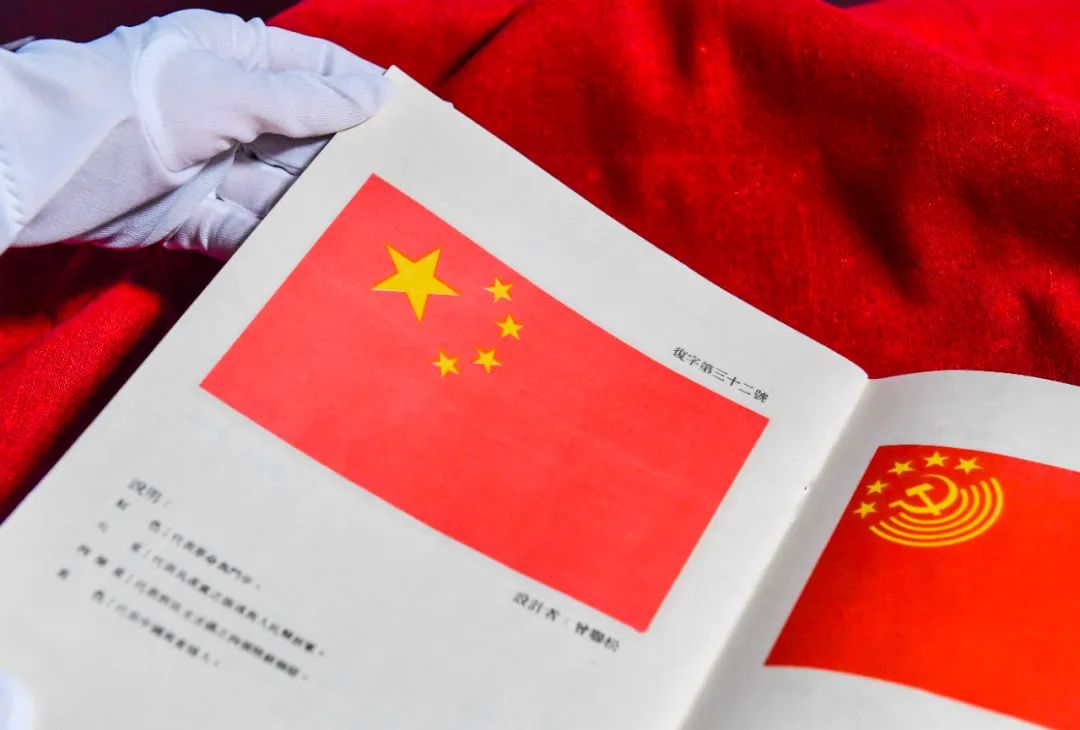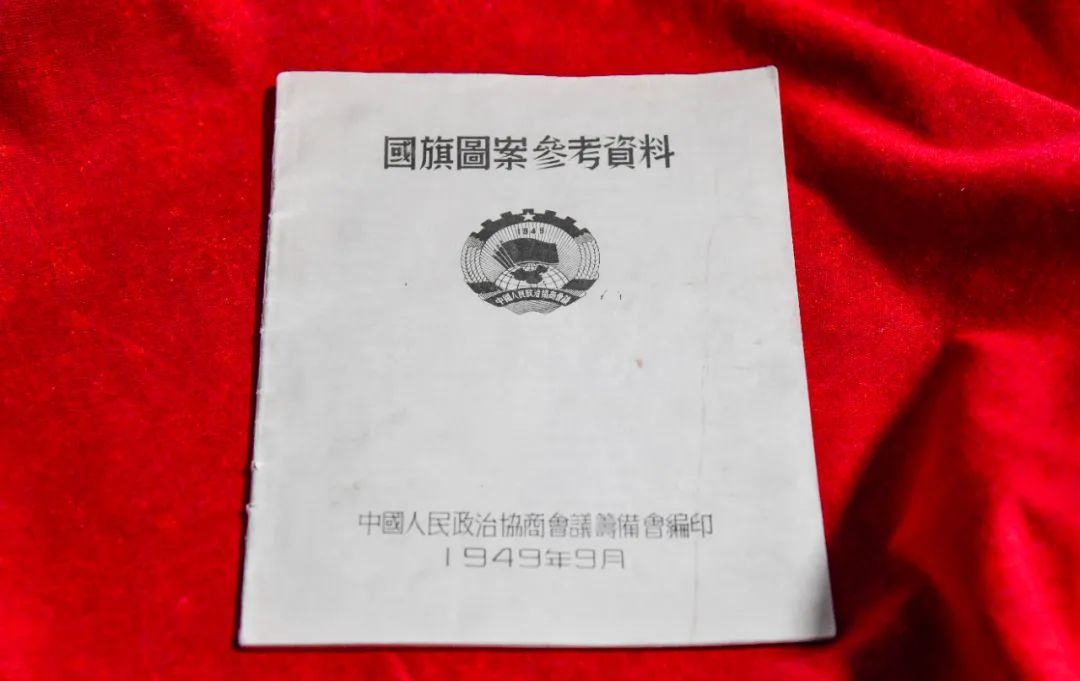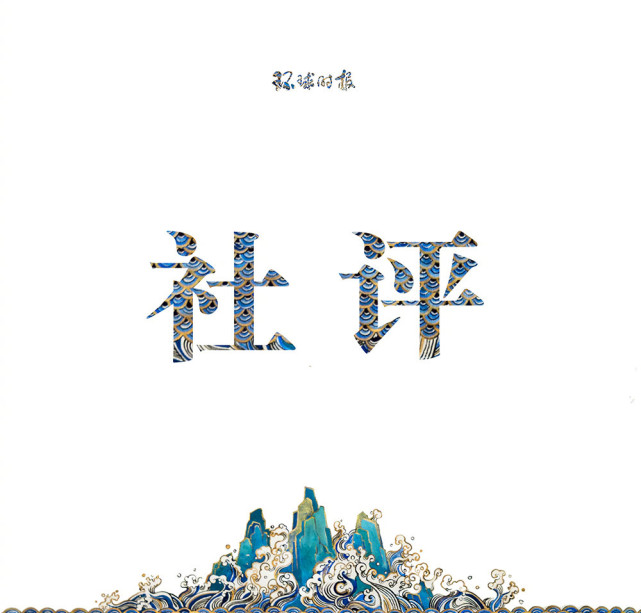In 1949, the five -star red flag he designed became the national flag
Author:Chongqing Daily Time:2022.07.22
Cultural relics
"National Flag Pattern Reference Data", national first -level cultural relics, is now collected in the History of the Chinese Democratic Party.
On June 15, 1949, the New CPPCC Preparation Association was held for the first time, and decided to publicize the national flag pattern at home and abroad. Chinese children at home and abroad have eager expectations for New China and actively contribute. After careful selection, the National Flag National Essence Selection Committee selected 38 from more than 3,000 design drafts and printed it into the "National Flag Pattern Reference Data" for review by the first plenary session of the CPPCC.
The 32nd pattern designed by Zeng Liansong, who works in Shanghai, was finally selected. On September 27, the first plenary session of the CPPCC voted through the five -star red flag as the national flag of the People's Republic of China.
The "National Flag Pattern References" witnessed the birth of the five -star Red Flag and witnessed the birth of the People's Republic of China.
Lecturer
Jiang Ye, deputy director of the History of Chinese Democratic Party, Jiangye

"The five -star red flag flutter the wind, how bright the victory is!"
Five -star red flag, our national flag, all the bright flags in the hearts of all Chinese children. However, not everyone knows, where does our national flag come from? Who is the designer? What are the meaning of its design elements?

On the morning of January 1, the People's Square of Chongqing, the New Year's Day flag event in our city was ongoing in 2022. (Data Picture) Reporter Lu Yue Photo/Visual Chongqing
"At that time, more than 3,000 national flag design drawings were collected nationwide. The" Five Star Red Flag ", which was numbered 32, had only 15 votes at first, and the number 3 of the number 3 got 185 votes. "
Let's follow Jiang Ye's telling and walk into the story behind the birth of the national flag.
A "hero post"
Once the solicitation notice was released, people picked up the brush to depict the appearance of the flag in their hearts.
On June 15, 1949, the first plenary meeting of the New CPPCC Conference was held in Peiping Zhongnanhai, who was short long after liberation. The important task of designing the national flag for New China was designated by the sixth group of the preparatory meeting.
The sixth group decided to issue a collection of consignment to the people of the country and overseas overseas Chinese.
"The national flag is a symbol of a country, and the central government attaches great importance to it." Jiang Ye said that for this reason, the group members of the sixth group were all "famous people in the cultural and art circles." The team leader was served as the standing committee member of the preparatory committee and the representative of the China Democratic Promotion Association, and the deputy team leader was the representative of the Chinese People's Liberation Army Ye Jianying and the Standing Committee of the Preparatory Association, and the representative of the cultural democracy Shen Yanbing (that is, Mao Dun). The team members include Zhang Yiruo, Tian Han, Ma Yinchu, Zheng Zhenduo, Guo Moruo, Qian Bozan, Qian Sanqiang, Cai Chang, Li Li San, Zhang Lan (Liu Wang Li Ming Dynasty), Chen Jiageng, Ouyang Yuqian, Liao Chengzhi.
Once the solicitation notation was released, more than a month, more than 3,000 design plans at home and abroad came from, from the founding of the founder to the writer, from ordinary people to architects.
"According to the instructions of Comrade Zhou Enlai, the preparatory will select 38 national flag patterns to compile a volume from the submitted draft and submit all the representatives of the first representative of the National Committee of the Chinese People's Political Consultative Conference. It contains the patterns designed by famous people such as Guo Moruo, Wu Yuzhang, Ai Qing." According to Jiang Ye, each pattern is attached to the number and complaints -Zeng Liansong's five -star red flag pattern is compiled as "Fu Zi No. 32", which forms the "National Flag Pattern Reference Data" we see now.
However, the five -star red flag pattern was not a "popular candidate" at that time. "The most popular at the time was the third national flag pattern, which was the next yellow bar of the five -pointed star." According to the Jiangye description, the national flag pattern is based on bright red. There is a yellow pentagram in the upper left corner. The yellow horizontal bar represents the Yellow River.
"As the mother of China's mother, the Yellow River has bred the culture of Huaxia for thousands of years. It is really novel to join the Yellow River element." Jiang Ye said that it was because it was incorporated into this element with Chinese characteristics. king". When voting, the support rate of the 3rd pattern is as high as 185 votes, and the five -star flag of "Fuzi No. 32" is only 15 votes.
At this time, Zhang Zhizhong, a well -known anti -Japanese patriotic general, believed that a horizontal bar "splitting" the flag into two halves was inappropriate and ambiguous. When everyone was difficult to choose, Comrade Mao Zedong held the last national flag fixed meeting in Zhongnanhai. 18 representatives from all walks of life including Zhou Enlai, Guo Moruo, Shen Yanbing, Huang Yanpei, and Chen Jiageng participated in the selection.
"Whether it is No. 32 or No. 3, everyone discusses the heat." Jiang Ye said that in the end, Mao Zedong pointed at the five -star red flag pattern and said that this pattern shows the people's unity. The five -star red flag is used as the national flag. After several considerations, the National Flag Selection Committee decided to take out Zeng Lian Song's original sickle and hammer pattern in the design, and finally formed the current five -star red flag.
A wonderful inspiration
"Stars, yes! Star!" Five Star Red Flag's conception flashed in the mind of this ordinary staff
Zeng Liansong, an ordinary Shanghai staff, has never had design experience. Why can his design draw the top from more than 3,000 works?
On July 12, the Chinese Democratic Party History Exhibition Hall, the staff showed the national flag pattern designed by Zeng Lianchang. Reporter Qi Lansen Photo/Visual Chongqing

Everything has to be spoken on July 15, 1949.
On the morning, Zeng Lian Song just arrived at the unit and was attracted by the "Liberation Daily" on the table. The eye -catching title wrote: "The New CPPCC will collect the national governments and national anthem of the national emblem at home and abroad."
Seeing this news, Zeng Liansong ripped in his heart: "Can I try it?" Zeng Lian Song came home when he got off work that day, and ran to the small loft without saying a word, cleaned and sorted it, and was determined to imagine in this inch loft. The national flag pattern in my heart.
All beginnings are hard. Zeng Liansong's design process was not smooth sailing, and it took a lot of nights, but his thinking was still blurred.
Until one night, when he was sitting in front of the attic window, he suddenly heard the Shanghai opera vocal coming from the window: "Looking forward to the stars, looking forward to the moon, and looking forward to the Communist Party of China ..."
"Stars, yes! Star!" Zeng Lian Song repeated the word in his heart. He suddenly opened up, the Communist Party of China was the great savior of the Chinese people! Thinking about it, the prototype of the five -star red flag came to mind. Because Mao Zedong proposed the four classes in "On the Democracy of the People's Democracy" -the working class, the peasant class, the urban petty bourgeoisie, and the national bourgeoisie, Zeng Liansong decided to use four small stars to represent the four classes, with a big star representative represented the representative The Communist Party of China, Xiaoxing means that the people mean that the people will always unite under the leadership of the party.
After spending a full month, Zeng Liansong finally designed a pattern that satisfied himself. In mid -August, only 5 days left before the draft, Zeng Lian Song sent his own design draft, with a design instructions.
A valuable information
It not only witnessed the birth of the flag, but also witnessed the birth of the People's Republic of China
"This" National Flag Pattern Reference Data ", which is collected in the History of the Chinese Democratic Party, is not small." Jiang Ye said that the owner of this cultural relic was the third brother of Lu Xun and one of the founders of the China Democratic Promotion Association.
The national first -class cultural relics "National Flag Pattern Reference Data" collected in the History of the Chinese Democratic Party. Reporter Qi Lansen Photo/Visual Chongqing

In September 1949, Zhou Jianren participated in the first plenary session of the Chinese People's Political Consultative Conference as a representative of the China Democratic Promotion Association. At the meeting, Zhou Jianren got this "National Flag Pattern References" and kept it properly with him.
In March 2011, the Chinese Democratic Party History Exhibition Hall opened. After the efforts of the exhibition hall staff, Zhou Jianren's daughter Zhou Yan and son -in -law Gu Mingyuan donated the "National Flag Pattern References" to the Chinese Democratic Party History Exhibition Hall.
The "National Flag Pattern References" is 26 cm long and 18.7 cm wide. The cover is black and black. It is printed with the emblem of the Chinese People's Political Consultative Council. In September 1949 The book is 42 pages, and the text is traditional. Among them, 38 pages are printed with different national flag design patterns, which are numbered separately, and the names and patterns of the designer are described below the pattern.
"This cultural relic not only witnessed the birth of the flag, but also witnessed the birth of the People's Republic of China." Jiang Ye felt that during the birth and development of New China, he experienced too many storms, and the revolutionary pioneers moved forward. Under the national flag, life is peaceful and happy. Today, no matter where we are, as long as we see the five -star red flag, we can feel the national pride that emitted from the depths of our hearts.
Chief Reporter: Zhou You
Editor: Zhao Ying Zhao Wen Boyu (intern)
- END -
Social Comment: The defense ability of the US nuclear command system is so unbearable?

According to the news of the dozen anonymous people on July 23, the United States ...
The medical team of Luohe Traditional Chinese Medicine Hospital goes to the Economic Development Zone to start again

War epidemic, set off again! At around 11 am on July 13th, Luohe Hospital of Tradi...